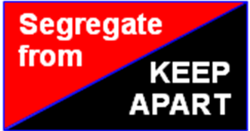The following chart shows the Chemical Segregation in accordance with HSG71 for general warehousing, however DSC Ltd recommend these segregations are considered generally, even when storing small quantities for example in laboratories.

Chemicals stored according to this table must comply with the following instructions:


Separation may not be necessary, but consult suppliers about requirements for individual substances. In particular, note that some types of chemicals within the same class, particularly Class 8 corrosives, may react violently, generate a lot of heat if mixed, or evolve toxic fumes.

his is used for organic peroxides, for which dedicated buildings are recommended. Alternatively, some peroxides may be stored outside in fire resisting secure cabinets. In either case, adequate separation from other buildings and boundaries is required.

Separate packages by at least 3 metres in the storeroom or storage area outdoors. Materials in non combustible packaging that are not dangerous substances and present a low fire hazard may be stored in the separation area. This standard of separation should be regarded as a minimum between substances known to react together readily, if that reaction would increase the danger of an escalating incident.
